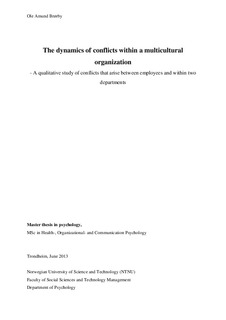| dc.contributor.advisor | Iversen, Anne | nb_NO |
| dc.contributor.author | Brørby, Ole Amund | nb_NO |
| dc.date.accessioned | 2014-12-19T14:43:05Z | |
| dc.date.available | 2014-12-19T14:43:05Z | |
| dc.date.created | 2013-11-22 | nb_NO |
| dc.date.issued | 2013 | nb_NO |
| dc.identifier | 666488 | nb_NO |
| dc.identifier.uri | http://hdl.handle.net/11250/271135 | |
| dc.description.abstract | The purpose of this study was to find out why different types of conflicts appear within an organizational context and what is causing the different types of conflicts within the organization and among the employees. This study builds on a collaboration with the NATO Airlift Management Program (NAMP) HR department. Qualitative methods have been used to illustrate that the research topic and the empirical data in the study is provided by personnel associated with two departments within the organization, the NAMP and the HAW (Heavy Airlift Wing). The study is based on a total of two focus group interviews, one employee satisfaction survey, three group discussions and field notes. Grounded theory has been used as method and analysis.
The findings show several dynamics, creating different patterns of conflicts within the organization and among the employees. The analysis identifies four key categories that affect the organization and the employees creating different patterns of conflicts. These were expectations among the employees, organizational change, multicultural work environment and management. The findings suggest that it is possible to assume that the different categories are strengthening each other, leading to the different patterns of the conflicts within each category, mainly since these dynamic processes are intertwined.
It seems that some of the conflicts that appear within the organization and among the employees are very conceptual and therefore are practically unavoidable. In any organization where more than one employee has to work with others conflicts will appear to a certain interpersonal level. Then there are other conflicts that are much more context-specific, where you can work on accommodate them and easier make the conditions better. The analysis suggests that the only category where it is most likely to introduce measures to make changes in times of conflicts is within the leadership, mainly because the leadership is the only one of the categories that carries a significant human factor. For future research, it may be interesting to examine more concrete examples that seem to promote and inhibit the dynamics of conflicts within the multicultural organization and among its employees. | nb_NO |
| dc.language | eng | nb_NO |
| dc.publisher | Norges teknisk-naturvitenskapelige universitet, Fakultet for samfunnsvitenskap og teknologiledelse, Psykologisk institutt | nb_NO |
| dc.title | The dynamics of conflicts within a multicultural organization: A qualitative study of conflicts that arise between employees and within two departments | nb_NO |
| dc.type | Master thesis | nb_NO |
| dc.source.pagenumber | 110 | nb_NO |
| dc.contributor.department | Norges teknisk-naturvitenskapelige universitet, Fakultet for samfunnsvitenskap og teknologiledelse, Psykologisk institutt | nb_NO |
